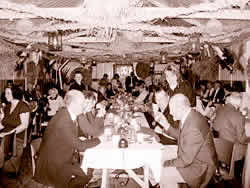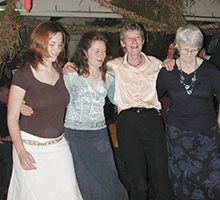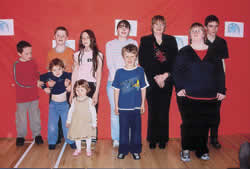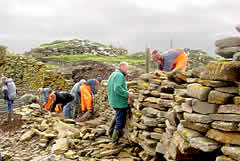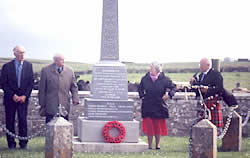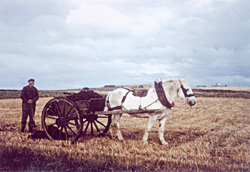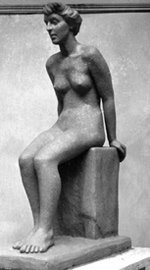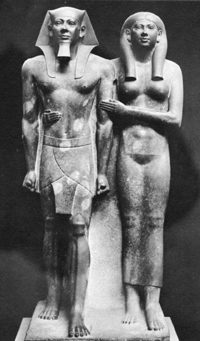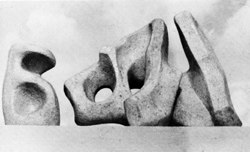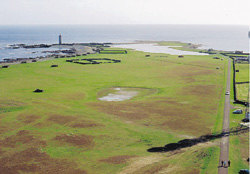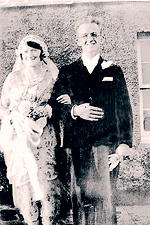Once I wrote a letter from North Ronaldsay called On being off-colour in the summer, in which I described how, for a week or so, I was forced to stay very firmly ‘a-bed’ as they say.
I’m of a mind to tell you of my latest change of fortune. It might serve as a cautionary tale for other potential victims – especially (but not exclusively) those getting on in years, and of how an island casualty gets in to Kirkwall. It’s also useful to remember some words of Burns: The best laid schemes o’ mice and men gang aft agley.
Yes, I shall try to be brief. What began, without any warning with a pain in my right thigh, lasting five or six days, developed, finally, one night, into a period of excruciating pain extending the full length of the leg.
After a time I was able to dose off. When I awoke, early in the morning, I discovered the pain had virtually gone, however the lower right side of my leg (from the knee down), part of my thigh and my foot – excluding the big toe – was ‘numbish’ with some pins and needles and I could not control my ankle from going over.
This (I assure you) alarming discovery, elicited the intervention of our local doctor which ended in a rather spectacular helicopter flight, in the moonlight, from the island, to Kirkwall, and thence to the Balfour Hospital.
The request for the air ambulance helicopter had been lodged, I think, about noon, to the control centre in Inverness.
The machine was somewhere in the Western Isles attending to an ambulance case.
An approximate arrival time was given as after 3pm, but then another emergency intervened.
A new time of arrival was estimated with the helicopter eventually landing at the local airstrip at about 5.50pm.
And so we touched down at the Kirkwall airport just after 6pm.
I’m, of course, not qualified to comment on the medical intricacies of all of this, but as I flew through the night sky I could not help but reflect on the fact that, had I been flying with the previous ambulance arrangements, operated so successfully by Loganair, I could have been at the Balfour Hospital within the hour.
I should say that the Balfour Hospital, and my treatment there, was more than one could wish for.
I was seen immediately by a doctor and later in the evening an x-ray was taken.
This, plus the assessment of the hospital surgeon and that of a consultant orthopaedic surgeon the following day, confirmed what I understood to be a prolapsed disc.
After a day or so I was seen by the head of the physiotherapy department, who also attended to my condition in a most professional manner. He gave me certain rehabilitating exercises to carry out and supplied me with some elbow sticks or crutches.
So, here I am, beginning to write this letter from Stromness where I have lodged for a week, living like, as Richie o’ Girnavald once said to his creel-boat crewman (but in a different context), a Jamaica tourist.
My cousin, Ella, has very kindly looked after me, taking me here and there, on first one enjoyable visit and then another, whilst, at home, my relatives have been as kindly, attending to my farming responsibilities.
Talking about my farming responsibilities, and just to end this account of my ‘aaps and doons’. I should mention, maybe as a warning, that on the final day of reckoning, I had unwisely, on my own, been tackling the re-heading of a stack of square bales.
As I had never got round to tying down the stack-in the summer (despite many lectures) that first earlier, furious gale of wind had lifted the loose hay heading, or the thatch, plus net, quite over the stack.
Although I had help to finish the job, the result of this foolishness ended in the way I have described.
I now return to my week’s stay in Stromness and my visiting sprees. How curious and true it is, that sometimes it takes unusual happenings, unwanted and unexpected, to make contact with, or see friends and acquaintances – even sometimes of years ago.
The fact that one’s home is on an island does limit contact with folk, whereas, living in a more central location, such as the Orkney Mainland, one’s socialising activities would be much easier.
Anyhow, I’m going to mention two particular individuals I made contact with, if I may, in a minute.
Apart from those two (I cannot list everybody) I saw and spent time with friends who, had I not been ‘laid a bittie doon’, I would not, as I said, have visited them at all.
Many subjects were discussed. Some were, appropriately enough, about back and leg problems by those who had experienced similar and worse symptoms than my own.
Other subjects turned over, with North Ronaldsay folk now living on the Mainland, went back through the years – island history and so on, including stories, some of which made me laugh more than I have done for months and months.
Incidentally, one uncomplaining, very Orcadian lady whom I met, (while waiting our turn at the physiotherapy department) and whom I had never seen before, made me stop and think.
I suppose she must have been in her mid 70s. She had two sticks. She told me that since the 1960s, when something had happened to her back which affected her legs, she had had to get about using those sticks and every day she had to take pain killers, but yet she soldiers on.
Imagine that for a moment – over 40 years of pain and restricted mobility. Let’s not complain for one moment about our misfortunes – difficult as that is for most of us.
Now, those two individuals I’m venturing to tell you just a little about – two Orcadians as it happens – and both rather remarkable men and both over 90.
Neither complained about anything and both were happily resigned to their circumstances.
As Johnny o’ Holland would have said, they took a philosophical view of their differing lives. One I visited in the Balfour Hospital. The other I spoke to at length over the phone.
At the hospital, to which I had been taken by car by (Mary Ann Thomson (formerly South Ness), a school classmate of the 40s and 50s, we both met Jock Harcus.
He had been an engineer along with other duties undertaken on the SS Earl Sigurd.
For many years he had worked on more than one boat, serving in various capacities. Folk of my generation, and many others, often sailed in the Sigurd on trips to and from the island.
So we knew most of the crew of those days. I think Jock said that he had been on the Earl Sigurd for 25 years.
The boat made her last voyage in 1969. We talked at length about those days and not without some nostalgia. He spoke with affection about the ship and the reliability of the old steam driven engine.
As young travellers, sometimes we were allowed to visit the engine room. He mentioned how once the Sigurd had sheltered in the lee of an island when threatened by tremendous winds.
Two anchors were dropped, but the engine was kept running with the propeller turning at a speed sufficient to hold their position.
We continued to talk about this and that, then I reminded him of the time he had stopped an animal from escaping up the pier – one for shipping – by catching it by the nostrils, and between that hand-grip and his other arm round the beast’s neck he brought it to its knees. It was shipped.
But such an action was achieved only by his legendary strength – to lift a 50-gallon barrel of oil was no problem. It was most enjoyable to relive those days and to listen to such a great character.
My other contact, by phone, was Jim Craigie, from the farm of Dale, just outside Stromness.
Jim Craigie, and his late wife Molly, had spent a few years in the 1940s and early 1950s at the farm of Holland, in North Ronaldsay, living life to the full in the lively island community of those days.
Of course at that time I was very young and not really acquainted with my elders of another generation. I knew their daughter, Mary, from our school days.
She is about my age and is presently back from Canada and staying with her father. However, the early death of a North Ronaldsay man, Jimmy Thomson (formerly Nether Linnay), who once worked for a time as a young man with Jim and Molly, put us in touch (I required some information for Jimmy’s obituary).
Now this latest escapade of mine got us together again – albeit over the phone. Those North Ronaldsay days feature highly with Jim I know.
Among his many recollections, he remembers the last days of the local football team (at one time there were two teams on the island).
He also mentioned the singling of turnips at Holland when islanders’ helped to single the many acres of ‘neeps’ grown on the farm.
After the work, a good meal and suitable refreshments, a dance was sometimes held in Holland’s large barn loft.
Most likely, we thought, the swinging accordion music of Ronnie Swanney, Trebb, would have rung through the summer night – maybe there were fiddles as well, though Jim could not quite remember.
We continued to ‘discoorse’ about this and that and laughed at stories – some not maybe safe to tell, but to have a talk with this dedicated farmer and cup-winning ploughman (even I noticed he was ploughing last year at one of those Mainland matches) was a real pleasure.
Well, I’ve come almost to the end of this longish letter. If you are wondering about the title, the whistling sticks are my elbow crutches.
When I walk with them outside, the wind plays curious little tunes through the series of adjusting holes.
I’m finishing with a prayer I spied pinned up on Ella’s notice board. It is an anonymous nun’s prayer from the 17th century. But that we all could practise it!
Lord, Thou knowest better than I do myself, that I am growing older and will some day be old. Keep me from the fatal habit of thinking I must say something on every subject and on every occasion. Release me from the craving to straighten out everybody’s affairs.
Make me thoughtful but not moody; helpful but not bossy. With my great store of wisdom it seems a pity not to use it all, but Thou knowest, Lord, that I want a few friends at the end.
Keep my mind free from the recital of endless details; give me wings to get to the point. Seal my lips from aches and pains. They are increasing, and love of rehearsing them is becoming sweeter as the years go by. I dare not ask for grace enough to enjoy the tales of others’ pains, but help me to endure them with patience.
I dare not ask for improved memory, but for a growing humility and a sureness when my memory seems to clash with the memories of others. Teach me the glorious lesson that occasionally I may be mistaken.
Keep me reasonably sweet; I do not want to be a saint – some are hard to live with – but a sour old person is one of the crowning works of the devil.
Give me the ability to see good things in unexpected places, and talents in unexpected people. And give me, Lord, the grace to tell them so.
Amen.

